11~ 2016 ''Twingings'' series,Yangmingshan Taipei
12~ 2017 Solo Show atRichmanTouch,Taipei
13~ 2018 ''Right & Wrong'' , Jimmy's Gallery, Taipei
14~ 2019 Solo Show at ECC Plazzo Mora Venice
11~ 2016 ''Twingings'' series,crossover cooperation with twingings, Yangmingshan Taipei, Taiwan
Liang Ping-Cheng, born in Pingtung, Taiwan, in 1958, is an important contemporary artist in Taiwan.
In 1981~1985, Liang studied in the Department of Fine Arts, Chinese Culture University. During his freshman year, he established “Art Group of Silly Birds”. In 1983, he wonthe Eighth Lion Art New Artist Award. In 1988, he went to New York for study. In 1998~2008, he was sculpturing in Sanyi. In 1999, he won YulonWood Carving Golden Award. In 2008~2013, he served as the representative artist in InSian Gallery, Taipei. In 2015, he was nominated for Taishin Arts Award.
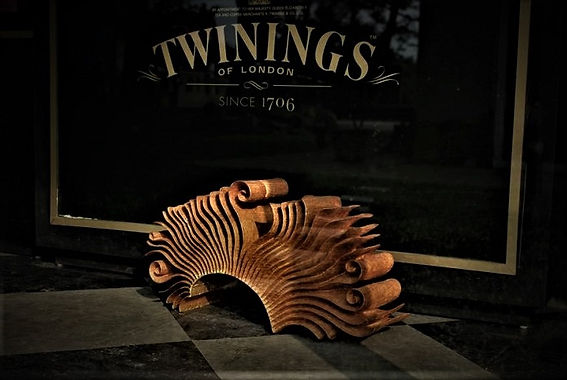
Liang’s painting and sculpture are centered on the nature of life and change of migrations. He presents his work with improvisational painting and going with flow in sculpturing. His theories and creative models are based on the aesthetics of inversion, as seen in Gravity Release.
Liang has hosted many solo exhibitions: first-ever improvisational painting in Jia-ren Gallery in 1985; the second improvisational painting in AIT American Cultural Center in 1987; sculpture exhibition in Pottery House 還原倉房in Sanyi in 2001; sculpture exhibition in Galerie Pierre, Taichung, in 2002; installation art “Fertile Land” 沃土in Herb 21, Eslite Bookstore Xinyi, in 2005; sculpture exhibition in InSian Gallery, Taipei, 2011; sculpture exhibition in Sanyi Wood Sculpture Museum in 2014; exhibitions in Art House, MOMA (fashion brand) and FEDS Mega City Banqiao Store in 2015. In 2016, Liang displayed 15 pieces of his work at the exhibition “Contemporary & Fashion”當代與時尚by working with Twinings on Yangde Boulevard.
12~ Solo Show atRichmanTouch,Taipei
Rich Man No.112/07/2012
Author: Li YiYi
Li spent a year in France as an exchange student in university. Soon after graduation, she worked as an editor in art magazines. She spent one year in Beijing in 2007-2008. She worked as a copy editor for Artist Magazine and Editor-in-Chief for “Art Collection”. She was also Editor-in-Chief for Taipei Post and later for Focus Art Magazine.
In 1983, Liang Ping-Cheng won the Eighth Lion Art New Artist Awardwhilst he was studying in Department of Fine Arts, Chinese Culture University. This was great encouragement to his creative journey.
At his personal exhibition upon graduation, he locked himself in the gallery and engaged in improvisational painting on the floors, the walls and the ceilings. This shows his nearly “wild” energy and momentum in his creative subconsciousness. He taught briefly and studied in New York University in the U.S. His encounter with wood sculpture seemed destined. He floated around for a few years after returning from the U.S. and came to Sanyi by chance. He picked up the wood pieces discarded by local sculptors and artisans and tried painting and carving on wood. Although he did not formally learn from a master, he came up with his own techniques by following his intuition and sensitivity. At that time, the wood sculpture industry in Sanyi was more of a handicraft, and the designs were based on traditional styles, without much innovation. In fact, the industry was struggling due to price competition from China.In contrast, Liang’s wood sculptures rose above his aesthetic foundation and creative trainings. Soon, his works became famous for his highly personalized style.

Liang’s wood sculpture is known for flows of lightness, transformed realism and personified pragmatism, and later the combination of heterogenous materials. Every artistic working with wood will be first overwhelmed by the sturdy and thick tree trunks. Wood carries a sense of heaviness that is difficult to resist. It is so substantial that it could crush a person with low spirit. On the other hand, wood is the material to “get it all out”. Liang uncovers a different kind of beauty on wood with a technique called “flows of lightness”. He removes a large area and sets free the seldom noticed beautify of wood with curves and square cavities. In this process, the artist lets go of emotional burdens and alleviate the astuteness of pain. After the series Gravity Release, Liang’s wood artworks are so slim and light that they can take flight. He later created Wings (飛行),Book & Illegible Book, Utensil & Anti-Utensil.
We all play different roles in the journey of life, as if we wear different masks from time to time. This was how his “Mask” series came into being. The integration of metals such as gold and stainless steel into wood sculpture provides a visual contrast, eye-catching but not overpowering. The series “Mask” is in fact a stateless face. Being stateless can be interpreted as a state.
Liang’s artworks speak of his mastery of materials and his passion for materials. From existence to void of wood, the process is letting go and gouging. From void reverting to existence, the process is imagination and integration.
Liang only uses wood from Taiwan. This gives his works a sense of belonging.
Through sculpturing and selection of materials, Liang expresses his ingenuity in three dimensions. His works are more than a visual delight. The fragrance of the wood sends off the bliss and love of Taiwan.

13~2018 Solo Show ''Right & Wrong'' , Jimmy's Gallery, Taipei ,Taiwan
Liang Ping-Cheng’s Wood Sculpture Takes Wings and Comes to Life
The China Times 17:10, February 5, 2018
Lee Hsin-tien
The teaspoon with a fish tail, the magic book hanging on the wall. These light, nimble wood sculptures are the creation by Liang Ping-Cheng. His artworks open a new expression for wood sculpture by giving heavy wood a light touch.
Born in Pingtung in 1958, Liang Ping-Cheng graduated from Department of Fine Arts, Chinese Culture University with a major in painting. His first encounter with wood sculpture was at the age of 40. After that, he dropped his painting brush and grabbed sculpture knife instead. Twenty years on, he said, “I treat each piece of wood as a friend. Each piece was an independent life. As much as we are. Whilst I am sculpturing, I am reading their life story so that I can come up with the looks that best suit them.”
Liang indicates that each tree and each wood piece are unique. This is the reason why he goes with the flows in his creative process. “I do not make sketches. Rather, I let my intuition talk to the trees. I believe that even decayed wood can be sculptured. Bug bite marks and rot traces are the testimony of life and existence. The process of sculpturing is to make the wood live again.”
His recent works Book & Illegible Book and Utensil & Anti-Utensil were displayed in his solo exhibition “Yes and No”是與非.He seeks to give utensils room to allow for imagination. In the process of sculpturing, he sets aside the idea of pragmatism. Utensils are no longer just utensils. Books are more than just books. “The elimination of functionality and purposefulness frees up the space for a variety of shapes and lines. This gives room for imagination”, said Liang.
Book & Illegible Book, one of his best-known works, are hanging on the wall. Flying pages and dancing chapters are frozen in wood sculpture. Liang commented, “This series also reflects that people nowadays do not enjoy reading. Therefore, the proportion ofexteriors being looked at is larger than the content of texts inside.”
Liang’s solo exhibition “Yes and No (是與非) is currently on at Jimmy's Garden, Taipei until March 31st.
(China Times)
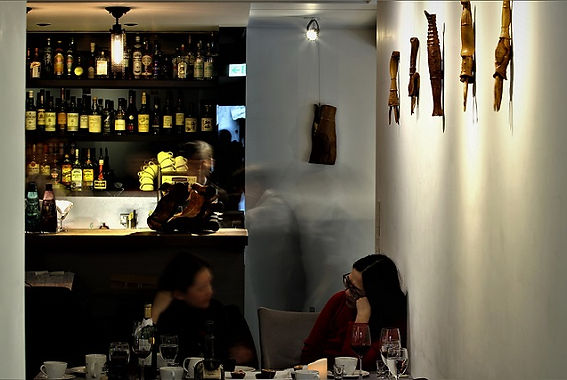
A Genius Will Always Shine: Rising from Rugs
Apple Daily
(Peng Hui-Zhen/Taipei)41281 22:57 February 21, 2018
Liang Ping-Cheng said that painting was the only thing he was good at in school.After he entered the Department of Fine Arts, Chinese Culture University, he learned about the development of arts in Europe and the U.S. from magazines. He was already a bit of avant-garde. He studied Western paintings and was into improvisation without sketches. At that time, he was at the forefront of the art world.
The reality is that artists need to take on other jobs to make a living. After graduation, he started teaching in Fu-Hsin Trade & Arts School. He wanted to see the world, so he sold his apartment after he got married. He took NT$2 million and his wife Wu Yi-Zhen (吳怡珍) to New York for studying.
He said, “My English is very poor, and I do not speak much at all.” However, all the schools accepted him after seeing his works, without imposing English-language requirements. He entered the Studio Art Program, NYC. However, he did not complete the degree because the streets of New York were more fun than classrooms. After he spent all the money within two years, he and his wife returned to Taiwan.
In 1998, he came to Sany and saw Bodhidharma, Ghost Chaser Zhong Kui and Holy Ruler Deity Guan craved with solid wood. He felt these statues were too heavy going. He wanted to hollow and release them. The burden on his chest allowed him to envision another beauty in wood. This time he was very sure that it was the path he wanted to take. He wanted to be himself again, at the age of 40, but it wasn’t easy. In the beginning, he sculptured small furniture pieces, such as penholders, for cash.“I was so happy whenever I got NT$1,000 for a piece of work. I could buy 20 lunchboxes with this money.”
For Liang, sculpturing is a process of letting go. Hollowing out wood lightens him up. This was how “Gravity Release” and Wings (飛行) were created. His sculpture does not constitute of flat lines. Rather, his works come with curves, as well as volume and void, to express the beauty of wood. “My works are surfaced with lines. A signature of my sketches in the past.”
One year later, an art gallery asked him to host an exhibition, and his works wonYulong Woodcarving Golden Award. It was not until then his art was seen by the world. After ups and downs in life, the wounds from the heaviest blow are not completely healed. “I want to say that we can all stand on our feet after we fall.” He thanks God for his blessing. “I am fortunate that I can do what I enjoy. I am very happy now.”
(Peng Hui-Zhen/Taipei)

14~2019 Solo Show at ECC Personal Structures Identitis Plazzo Mora Venice

Sculptor Liang Ping-cheng shows his series works in Venice, where many visitors are amazed by his concept and creation.
The exhibition will be shown untill 24 November 2019 at Palazzo Mora Venice.

“From the context of contemporary art, the concept of “inverted aesthetics” and the idea of unreadable books, unuseful objects are the mix combination of ready-made objects, conceptual art and appropriation theory, all together they become the aesthetic declaration to support the structure of my art creation.”
L’artista taiwanese Liang Ping-Cheng espone una selezione delle sue sculture a “PERSONAL STRUCTURES - Identities” nella sede di Palazzo Mora.
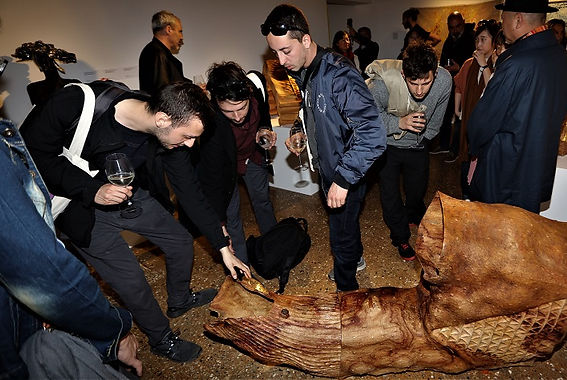
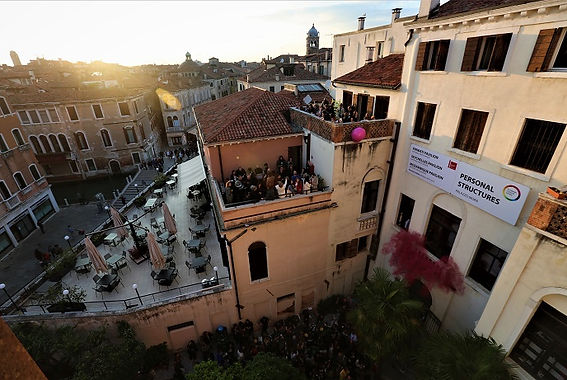
15~ Solo Show ''Like A Book'' , Jimmy's Gallery, Taipei ,Taiwan
Finding a place for hosting for a better obstinacy—About Liang Ping-Cheng’s Art
Books bound in a flurried manner turned out to be mosses on youth
Traces of the commotion in Liang’s innermost hidden behind the passing years have been best manifested in his “Book & Illegible Book” Series. In his wood sculpture creation, Liang has never yielded himself to the confinement set by concepts of realism when depicting the subjects. Liang has strived for form deconstruction in both “Book & Illegible Book” and “Utensil & Anti-Utensil” Series, and such an intention to ease restrictions on forms has allowed creative representations of more freedom. But breaking away from reification in realism does not mean to practice “laissez-faire” in art creation. On the contrary, I have noticed from Liang’s sculptural artworks an access he took from real objects to accomplish deconstruction of forms with his personal interpretation of such objects taken in by eyes. Once the frame is removed, embodiment of his idea to shapes and practical functions of the subjects would become possible, and thus unique sculptural art language of his own can be presented. Among all Liang’s creations, artworks in the “Book & Illegible Book” Series can be considered the ones best allow viewers to first appreciate with their sense of vision followed by hearing the minute rustling sounds flapped about by the wind with bated breath. Such satisfaction to the sense of vision and hearing have been fully manifested particularly by this series.

Liang knows it very well that it would be difficult to make the artworks thin and transparent with the medium he has chosen because of inherent restrictions by weight and color sensation of wood. This explains why Liang depicts books taking forms of open-book leaves. Lift-up book leaves not only take away the heaviness but bring in better readability to the vision.
In Liang’s artworks of “Book & Illegible Book” Series, there exist serious themes worth further discussion. Firstly, as a nature-loving artist, Liang, no matter in Sanyi in the past or currently in northern Taiwan, has always established his workplace close to nature, lending him opportunities to grow the habit of learning from the natural world. To Liang, nature is like an opened-up book which treats the multitudes impartially but takes an inactive role. In other words, the multitudes, in particular those with self-consciousness, shall look at the book leaves and meditate on their own. Based on life experience to express his thoughts and emotions, Liang has found an unusual but appropriate cut-in for these creations. Secondly, the material of book leaves comes from trees. Trees, after chemical transformation that changes the nature thereof, continue to serve the multitudes in a different form of life. The key lies in that it is knowledge brought about to humans by such changes making trees to become the largest knowledge platform. Actuality and spiritual deepening linked up with all the above and would be something of interest.
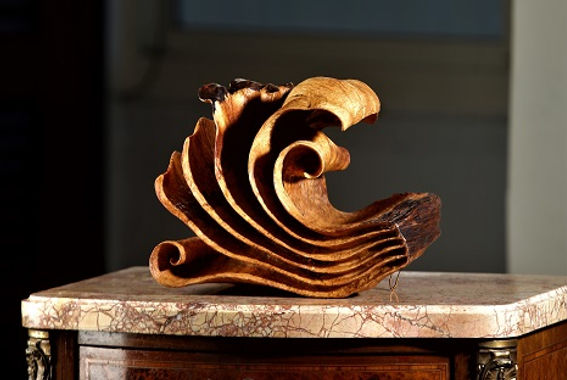

When working on workpieces of this series, Liang skillfully manipulates color and luster of wood to create a classical atmosphere for the artworks to be presented in front of viewers. It seems to be a giant book rendered by nature to the multitudes, passing down from early generations, with yellowing leaves and creased corners, unlike those in an unread book, firm, fresh and crisp. Books from nature brought to us by Liang at the moment are like the ones in the ancient time, bound together leaf by leaf, old and beaten by temperatures and humidity from the environment and hand perspiration when flipping through plus reading notes from various readers. Closely interlocked and inseparable with one another, what these books have experienced makes it difficult to resume the books to their original neat and fresh state. However, perhaps traces left by time and the multitudes would contrarily highlight the vicissitudes of life and undeprivable self-esteem. To ponder it further, one may discover that it is the annual ring that we use to determine the age of a tree while a tree shall go through years of weather before becoming the material for papermaking. Isn’t it the same as what it takes for the multitudes to accumulate knowledge? It also takes time to accomplish. In selecting material for wood sculpture, Liang not only chooses what to be used for art creation but spends efforts in exploring possibilities for infinite imagination. Maybe it is such efforts that allow him to go beyond the art in his wood sculpture and make known his attitudes towards the material used as well as communication conveyed by the material, which creates more space for dialogues. Had he not experienced significant ups and downs in his life, Liang would not have learned to hold a humble and restraining state of mind in front of nature and would not have sensitivity to feel the infinity of life.
當代藝術新聞 05/2011 No.76
CansART News No.76 May/2011
文/鄭乃銘 by Cheng Nai-Ming
16~ 2023 Solo Show atART Fair Asia FUKUOKA
~Splender in simpliciity

Splendor in Simplicity
LIANG is not aiming at creating “Hyperrealistic” works and thus it is not about how realistic his works are when we appreciate his art. Although we cannot “read” “Book & Illegible Book” but this serial works of art enables us a direct association that this unreadable book comes from wood and vice versa. This evolving translation of imagery enriches the work’s meaning and leads us to further explore its aesthetic concept. Undoubtedly, LIANG knows the exact place of his artworks, that is quite on the border between modern and contemporary, tradition and innovation.
The female figurine in the “Mask” series is neither personificationnor a ready image. The material itself is treated as the body of life. Liang merely lays bare the beauty of wood with an artistic form. The rising torso, proportional breasts and hips, and soft spine curvature resonate the time-honoured classical beauty of the human body. The facial expression is deliberately faded in order to give way to storytelling. Masks are not to cover or change the identity or to hide the facial expression. Rather, they convey multiple and comprehensive meanings for the image of a head. I do not think Liang intends to discuss the authenticity or hypocrisy of the character, or the conflict between spontaneity and performing.Liang is showing the beauty of life with different shapes.
Art Fair Asia Fukuoka Booth A2
Liang Ping-Cheng
Curator Emerson WANG
2023/9/21 vip preview
2023/9/22-24 public days

